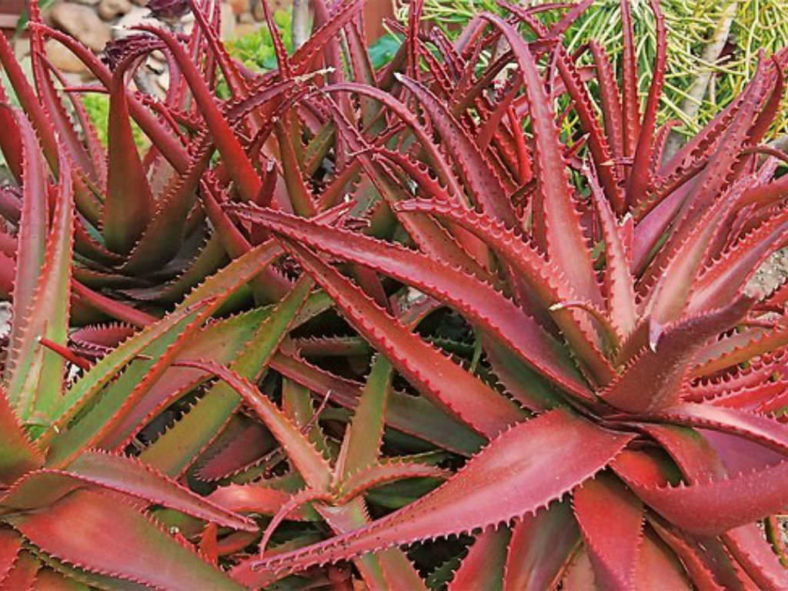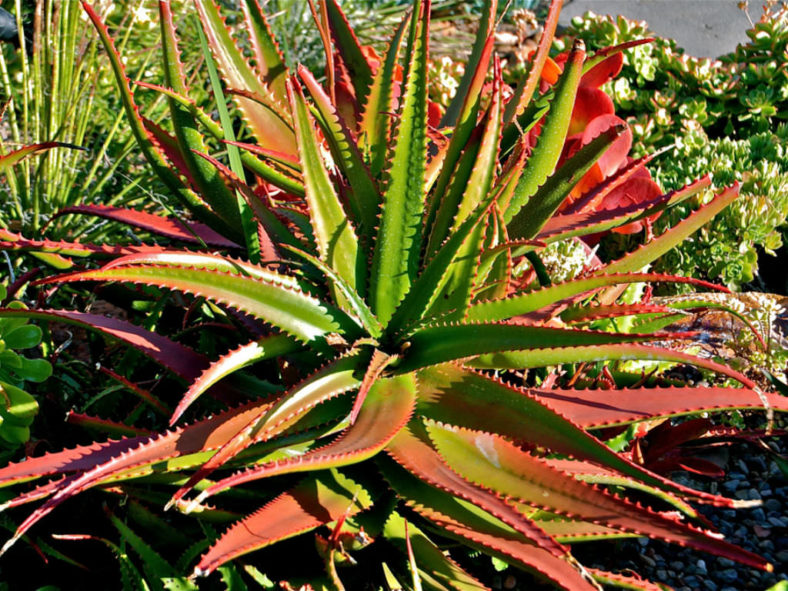Scientific Name
Aloe cameronii Hemsl.
Common Name(s)
Red Aloe, Cameron's Ruwari Aloe
Synonym(s)
Aloe cameronii var. cameronii
Scientific Classification
Family: Asphodelaceae
Subfamily: Asphodeloideae
Genus: Aloe
Etymology
The specific epithet "cameronii (kam-er-ON-ee-eye)" honors Kenneth J. Cameron, an employee of the African Lakes Corporation, who discovered the species in Malawi and sent it to the Royal Botanic Garden at Kew in 1854.
Origin
Aloe cameronii is native to Malawi and Zimbabwe. It grows in crevices and grass-filled depressions on granite hills and cliffs at elevations between 2,300 and 5,200 feet (700 and 1,585 m), mainly in exposed situations but occasionally among other shrubs.
Description
Aloe cameronii is an attractive shrubby succulent with erect stems clothed in persistent leaf remains and topped by a lax rosette of green leaves that turn a beautiful coppery red in summer. It branches from the base and above and can grow up to 5 feet (1.5 m) tall, rarely to 8.2 feet (2.5 m) when supported by surrounding vegetation. The numerous branches are ascending, or the basal ones shortly decumbent. The leaves are erect-spreading, lance-shaped with margins lined with brown-tipped teeth, and can measure up to 20 inches (50 cm) long and 2.8 inches (7 cm) wide.
The flowers are usually bright red with paler tips or orange and occasionally creamy yellow. They are slightly curved, measuring up to 1.8 inches (4.5 cm) long and 0.3 inches (0.7 cm) in diameter. They appear arranged in racemes with a branched peduncle, usually in late fall and winter. The racemes can reach up to 12 inches (30 cm) in length. The inflorescences, 1 to 3 from each rosette, are erect and can grow up to 3.3 feet (1 m) tall.

Hardiness
USDA hardiness zones 9b to 11b: from 25 °F (−3.9 °C) to 50 °F (+10 °C).
How to Grow and Care
Aloes can live long and thrive with very little care. These plants are great for beginners.
When growing Aloes indoors, place your plants near a southern or southwest-facing window with plenty of bright, indirect light. To keep your Aloes looking green, avoid exposing them to direct sun, which can cause leaves to brown. Rotate the pots once or twice a week to receive equal lighting for all sides of the plants. Rotating your Aloe also helps balance the look of the plant, as leaves tend to grow toward the sunlight.
Outdoors provide light shade, especially during the hottest parts of the day. A covered patio or porch is an excellent spot for growing Aloe outdoors.
Plant Aloes in well-drained soil specially formulated for cacti and other succulents, or make your soil mix. Drainage is essential because too much moisture around roots can cause root rot.
These succulents need regular watering but are very tolerant of short periods of drought. Water deeply, but only when the soil is completely dry. Cut back on watering during the winter months. Overwatering is the top reason Aloe plants die. Do not let water stand in the rosettes.
Learn more at How to Grow and Care for Aloe.
Hybrids
Links
- Back to genus Aloe
- Succupedia: Browse succulents by Scientific Name, Common Name, Genus, Family, USDA Hardiness Zone, Origin, or cacti by Genus
Photo Gallery
Click on a photo to see a larger version.

